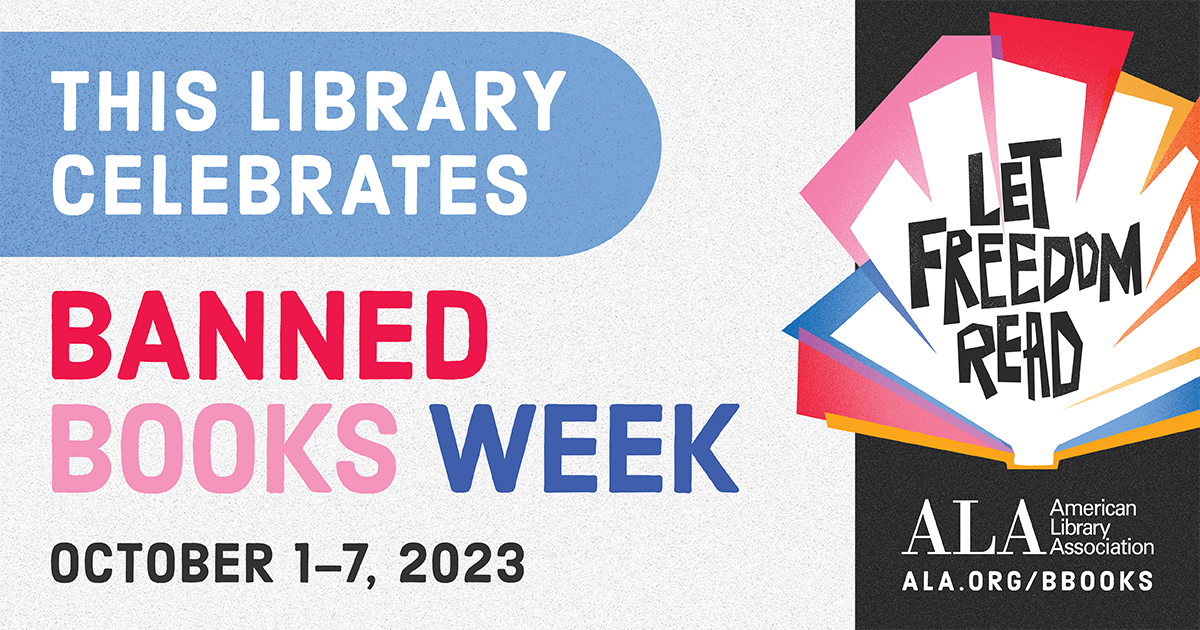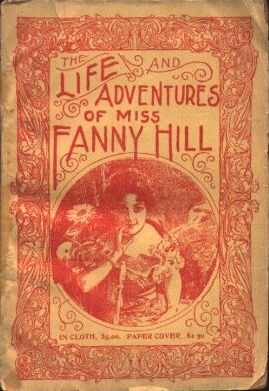
Banned Books Week celebrates the freedom to read and spotlighting current and historical attempts to censor books in libraries and schools. For 40 years, the annual event has brought together the entire book community — librarians, booksellers, publishers, journalists, teachers, and readers of all types — in shared support of the freedom to seek and to express ideas, even those some consider unorthodox or unpopular. The books featured during Banned Books Week have all been targeted for removal or restriction in libraries and schools. By focusing on efforts across the country to remove or restrict access to books, Banned Books Week draws national attention to the harms of censorship.
- What are banned books?
-
The American Library Association (ALA) defines challenged books, banned books, censorship and intellectual freedom as the following:
A challenge is an attempt to remove or restrict materials, based upon the objections of a person or group.
A banning is the removal of those materials. Challenges do not simply involve a person expressing a point of view; rather, they are an attempt to remove material from the curriculum or library, thereby restricting the access of others.
Censorship is a change in the access status of material, based on the content of the work and made by a governing authority or its representatives. Such changes include exclusion, restriction, removal or age/grade level changes.
Intellectual freedom is the right of every individual to both seek and receive information from all points of view without restriction. It provides for free access to all expressions of ideas through which any and all sides of a question, cause or movement may be explored.
- What books are frequently banned?
-
The American Library Association collects reports of book challenges and bans, and publishes lists of the most frequently banned books each year. The ALA Office for Intellectual Freedom tracked 729 challenges to library, school, and university materials and services in 2021. Of the 1597 books that were targeted, here are the most challenged, along with the reasons cited for censoring the books:
Gender Queer by Maia Kobabe
Reasons: Banned, challenged, and restricted for LGBTQIA+ content, and because it was considered to have sexually explicit imagesLawn Boy by Jonathan Evison
Reasons: Banned and challenged for LGBTQIA+ content and because it was considered to be sexually explicitAll Boys Aren’t Blue by George M. Johnson
Reasons: Banned and challenged for LGBTQIA+ content, profanity, and because it was considered to be sexually explicitOut of Darkness by Ashley Hope Perez
Reasons: Banned, challenged, and restricted for depictions of abuse and because it was considered to be sexually explicitThe Hate U Give by Angie Thomas
Reasons: Banned and challenged for profanity, violence, and because it was thought to promote an anti-police message and indoctrination of a social agendaThe Absolutely True Diary of a Part-Time Indian by Sherman Alexie
Reasons: Banned and challenged for profanity, sexual references and use of a derogatory termMe and Earl and the Dying Girl by Jesse Andrews
Reasons: Banned and challenged because it was considered sexually explicit and degrading to womenThe Bluest Eye by Toni Morrison
Reasons: Banned and challenged because it depicts child sexual abuse and was considered sexually explicitThis Book is Gay by Juno Dawson
Reasons: Banned, challenged, relocated, and restricted for providing sexual education and LGBTQIA+ content.Beyond Magenta by Susan Kuklin
Reasons: Banned and challenged for LGBTQIA+ content and because it was considered to be sexually explicit. - Are there laws about banning books?
-
Many laws restricting access to materials tend to focus on materials available in K-12 schools, or exposure of obscene materials to minors. The First Amendment rights of minors, especially in school settings, are not as broad as those of adults. Some state laws extend to universities, and public libraries and some laws make it a criminal offense to provide access to materials deemed obscene or perverse.
Since 2021 PEN America has tracked the introduction of 185 education focused bills in 41 states. Nineteen have become law in 15 states.
North Dakota defines obscene as
a. Taken as a whole, the average person, applying contemporary North Dakota standards, would find predominantly appeals to a prurient interest;
b. Depicts or describes in a patently offensive manner sexual conduct, whether normal or perverted; and
c. Taken as a whole, the reasonable person would find lacking in serious literary, artistic, political, or scientific value.
Whether material or a performance is obscene must be judged with reference to ordinary adults, unless it appears from the character of the material or the circumstances of its dissemination that the material or performance is designed for minors or other specially susceptible audience, in which case the material or performance must be judged with reference to that type of audience. Century Code 12.1-27.1-01.
Federal Laws
The primary law used to ban books was the Comstock Laws, the first of which was passed on March 3, 1873, as the Act for the Suppression of Trade in, and Circulation of, Obscene Literature and Articles of Immoral Use. This prohibited the use of the U.S. Postal service to send obscene content including personal letters. Another law in 1909 prohibited the use of private carriers such as railroads from transporting these materials. Section 305 (a) of the Tariff Act of 1922 forbade the importation of any contraceptive information or means. Those found guilty of violating the act could be fined up to " $5,000, (Equivalent of $87,655.62 in 2022) or by imprisonment at hard labor for not more than ten years, or both."
Comstock laws were rendered moot by by Supreme Court decisions Griswold v. Connecticut (1965) and Eisenstadt v. Baird (1972).
Supreme Court
The First Amendment guarantees freedom of speech and press but the Supreme Court has established guidelines, or tests, for defining what constitutes protected and unprotected speech. Courts have ruled that obscenity and materials encouraging the overthrowing of the government is not protected.
Gitlow v. New York (1925), the Supreme Court has applied the First Amendment freedoms of speech and press to the states through the due process clause of the Fourteenth Amendment. The court ruled government could suppress publications advocating to “overthrow and destroy organized parliamentary government”
Roth v. United States (1957). Roth was charged with sending obscene materials through the mail. This case resulted in a series of criteria by which to judge a work based on contemporary community standards and if a work appealed to a “prurient interest in sex, and whether the material was utterly without redeeming social value.” Some obscenity charges against Roth, who had been publishing a magazine called American Aphrodite, were upheld.
Jacobellis v. Ohio (1964) Could the state of Ohio ban the showing of Louis Malle’s film The Lovers? Manager of an art theater, Nico Jacogellis was convicted of possessing and exhibiting an obscene film in 1964. He appealed and the Supreme Court found the work was not obscene.
“I shall not today attempt further to define the kinds of material I understand to be embraced within that shorthand description ["hard-core pornography"], and perhaps I could never succeed in intelligibly doing so. But I know it when I see it, and the motion picture involved in this case is not that.”- Justice Potter Stewart

Memoirs v. Massachusetts (1966), Fanny Hill, a novel by John Cleland and first published in 1748, was outlaws in Massachusetts in 1821. The publisher, Peter Holmes, was convicted for printing a lewd and obscene novel. The judge called him "a scandalous and evil disposed person." In 1963 Putnam republished the book with a different title leading to the arrest of a book seller and leading to Memoirs V. Massachusetts which found the book to not be obscene. A plurality of the Court, in an opinion by Justice Brennan, articulated a new three-part test:
“(a) the dominant theme of the material taken as a whole appeals to a prurient interest in sex;
(b) the material is patently offensive because it affronts contemporary community standards relating to the description or representation of sexual matters; and
(c) the material is utterly without redeeming social value.”Miller v. California (1973), Believing that the previous criteria was too ridged this court adopted a test that elaborated on the standards established in Roth v. United States. Miller defines obscenity by outlining three conditions for jurors to consider:
“(a) whether the ‘average person, applying contemporary community standards,’ would find that the work taken as a whole appeals to the prurient interest;
(b) whether the work depicts or describes in a patently offensive way, sexual conduct specifically defined by applicable state law; and
(c) whether the work taken as a whole lacks serious literary, artistic, political, or scientific value.”
The court ruled that obscene material was not protected by the First Amendment. The charges against Marvin Miller (aka King of Smut) were not overturned.
- Famous/ infamous banned books
-
One of the most striking images of censorship is the burning of books. This form of censorship has been around since humans started writing on flammable media. A list of List of book-burning incidents provides a sense of the scope of the issue and the reasons people take this action. When printing was still new the act of burning a book could destroy one of the few copies that existed, now the action is primarily symbolic. At different times in history the author may have also been in danger.
New English Canaan, Thomas Morton,1637 (The first banned book in Colonial North America)
English businessman Thomas Morton did not agree with his puritan neighbors who did not appreciate his celebration of old world customs, maypole or his more friendly attitude to the indigenous people. He returned to England where he wrote his book, despite being "tried for supplying arms to the Natives, and expelled to an island off the coast of New Hampshire to be left for dead." read moreRelación de las Cosas de Yucatán, 1566, friar Diego de Landa documented his efforts to “remove the demons” from the natives’ hearts. On July 12, 1562, at the village of Mani, “We found a large number of books in these characters and, as they contained nothing in which were not to be seen as superstition and lies of the devil, we burned them all, which they regretted to an amazing degree, and which caused them much affliction.” These were most likely family histories. Many of the villagers were also tortured and killed.
Ulysses, 1920, James Joyce's epic novel had been published as a serial in the magazine, The Little Review, since 1914 but in 1920 a specific chapter caught the attention of a powerful group, the New York Society for the Suppression of Vice (NYSSV). The NYSSV was an organization supported by government officials to supervise morality. Founded in 1873 the group worked with the courts and district attorneys to enforce state laws regarding immoral conduct and were allowed to search, seize, and arrest. In 1920 they were able to get Ulysses banned in the United States. Copies were seized, including by the U.S. Postal Service which burned the book when found. The book was banned until the 1932 trial United States v. One Book Called Ulysses and not sold in the U.S. till 1934.
The Satanic Verses, 1988, by Salman Rushdie. Some people found the book to be blasphemous leading to debates, violence and threats against the author who went into hiding for a decade. The Japanese translator Hitoshi Igarashi, was stabbed to death in 1991 and assassination attempts against Rushdie include an attempt on his life in August 2022. The book has been banned in India, Bangladesh, Egypt, Iran, Pakistan, and South Africa.
